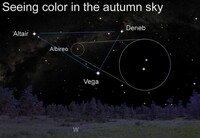Week of November 23-29, 2025
Many stargazers are surprised to learn that stars do not all appear the same but actually display different colors. Those that appear white are hotter than those that are orange or red. And bluish stars are the hottest of all.
Of course, not everyone can see color, but those who can still have a tough time with it. The human eye's color receptors do not respond well to faint light. You know this is true if you've ever looked around a darkened movie theater; shapes and shades of gray are pretty easy to spot, but colors are virtually nonexistent.
The same is true with stars. Only the brightest display their colors for our eyes, but if two differently colored stars appear next to one another, the contrast between them becomes quite discernible. This autumn, there is a place in the evening sky where such a colorful contrast exists, but you'll need a small telescope to see it.
I'm talking about the star Albireo, and it's located not too far from the center of the Summer Triangle, now appearing midway up in the west after dark.
With the naked eye, Albireo appears as a single star, no matter how good our vision. Even binoculars don't show it as anything more. But aim a small, backyard telescope in its direction and you'll discover that the light you've been seeing comes from two separate stars.
Even more impressive is that each of these stars appears to be a different color. The astronomy writer Agnes Clerk wrote in 1905 that the tints "golden and azure" gave perhaps "the most lovely effect of color in the heavens." I suspect that anyone viewing Albireo through a small telescope will surely agree.
Its two stars (individually named Albireo A and Albireo B) not only display stunning colors but inform us of a fundamental property of stars as well: their temperatures. Albireo A is a yellow star (around 7,400 F and about 69 times larger than our sun), and Albireo B is a bluish star (around 23,000 F and about 3 times larger than the sun).
Astronomers still don't know much about these stars. We believe the pair lies about 400 lightyears from us, which means the light we see from it has been traveling in our direction since the early part of the 17th century. But we don't yet know if the two orbit a common center of gravity or if they just appear along the same line of sight.
The unusual name Albireo has its roots in historical misunderstandings and mistranslations. Early Arabic texts originally called it "al-Minhar al-Dajajah" (meaning "the hen's beak"), but Latin scholars misunderstood that the name had come from a kind of herb and translated it as "ab ireo" (meaning "from ireus"). Eventually, people considered this a misprint and transcribed it as "al-bireo."
Whatever you call it, be sure to check out this celestial showpiece when you get a chance. It will be visible for another month or so as it appears lower to the west with each passing week. If you miss it, don't worry; Albireo will return to our evening skies next summer.
Visit Dennis Mammana at dennismammana.com. To read features by other Creators Syndicate writers and cartoonists, visit the Creators Syndicate website at www.creators.com.
The binary star Albireo will be visible by telescope this week.







View Comments